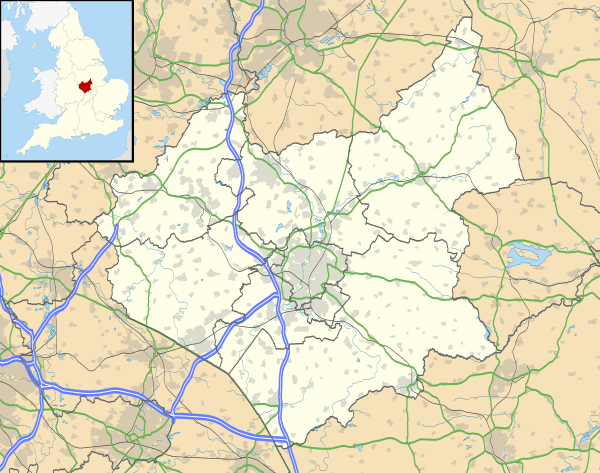Langley Priory
Langley Priory is a former Benedictine nunnery in Leicestershire, England. It is located around a mile and a half south of East Midlands Airport; around a mile from the village of Diseworth. Population figures are included in the civil parish of Breedon on the Hill.
 Location within Leicestershire | |
| Monastery information | |
|---|---|
| Other names | Langley Nunnery |
| Order | Benedictine |
| Established | c.1150 |
| Disestablished | 1536 |
| Mother house | Farewell Priory |
| Dedicated to | "God and to the Blessed Virgin" |
| Diocese | Diocese of Lincoln |
| People | |
| Founder(s) | William and Burgia Pantulf |
| Site | |
| Location | Leicestershire, England |
| Coordinates | 52.807776°N 1.358197°W |
History
Langley Priory was founded c.1150 by William Pantulf and his wife Burgia. The first nuns who came to Langley came from Farewell Priory in Staffordshire.[1] William donated the advowsons of the churches of Little Dalby and Somerby, and land in Langley, Little Dalby, Somerby and Tonge. Burgia donated land in Kettleby and tithes in Tonge and Wilson. Before 1205 the priory had also acquired land in Burrough, Diseworth, Long Whatton, Nottingham and Prestwold. The nuns also gained the advowson of Diseworth Church before 1220. By 1291 the priory was receiving an annual income of £20. 9d. from its temporalities.[2]
The priory was founded in the Benedictine Order; in the late 13th century the nuns claimed to belong to the Cistercian Order, as this allowed them to avoid paying tithe on their lands.[2] They were, however, forced to abandon their claims.[1]
In 1354 the priory was visited by John Gynwell, Bishop of Lincoln, who recorded there were 12 nuns at the priory. A later visit by William Alnwick, Bishop of Lincoln, in 1440, reveals the number of nuns had fallen to eight, and that the priory's income had fallen, pushing the nuns £50 into debt.[2]
The Valor Ecclesiasticus of 1535 lists the priory as having an income of £29. 7s. 4½d. In June 1536 the priory is recorded as being home to six nuns and the prioress.[2] It was probably dissolved with the other small monasteries in 1536.[1]
Prioresses of Langley Priory
- Rose, occurs 1229.
- Burgia, elected 1229-30.
- Isabel of Leicester, elected 1236-7, occurs 1265.
- Juliane of Winchester, appointed 1269.
- Alice of Tatyrsal, occurs 1275, died 1276.
- Margaret of Leicester, elected 1276, occurs 1278-9.
- Christine of Winchester, occurs 1284, resigned 1294-5.
- Amice de Burgh, confirmed 1295, died 1302.
- Alice Giffard, elected 1302.
- Elizabeth of Caldwell, elected 1306, occurs to 1332.
- Joan of Outheby, occurs from 1333 to 1336.
- Matanye, occurs 1350.
- Maud, occurs 1355.
- Margaret de Sulveye, occurs 1355 to 1374.
- Margaret Salhowe, occurs 1430.
- Margaret Pole, occurs 1441, resigned 1447-8.
- Margaret Bellairs, elected 1447-8, resigned 1485.
- Anne Shafton, elected 1485.
- Dulcia Bothe, occurs from 1507 to 1535.[2]
After Dissolution
The remains of the priory were thought to have been incorporated into a later house which was also called "Langley Priory".[1]
Little of medieval origin remains within the current house: the central block was completely rebuilt in the early 19th century, and the two wings were largely rebuilt in the 16th and 17th centuries.[1]
The house is currently used as a wedding venue. Despite its being in Leicestershire, the business' website claims the house is in Derbyshire.[3]
References
- Langley Priory, English Heritage: PastScape
- 'House of Benedictine nuns: The priory of Langley', A History of the County of Leicestershire: Volume 2 (1954), pp. 3-5. Date accessed: 24 June 2013
- Langley Priory Archived 2013-07-28 at the Wayback Machine

